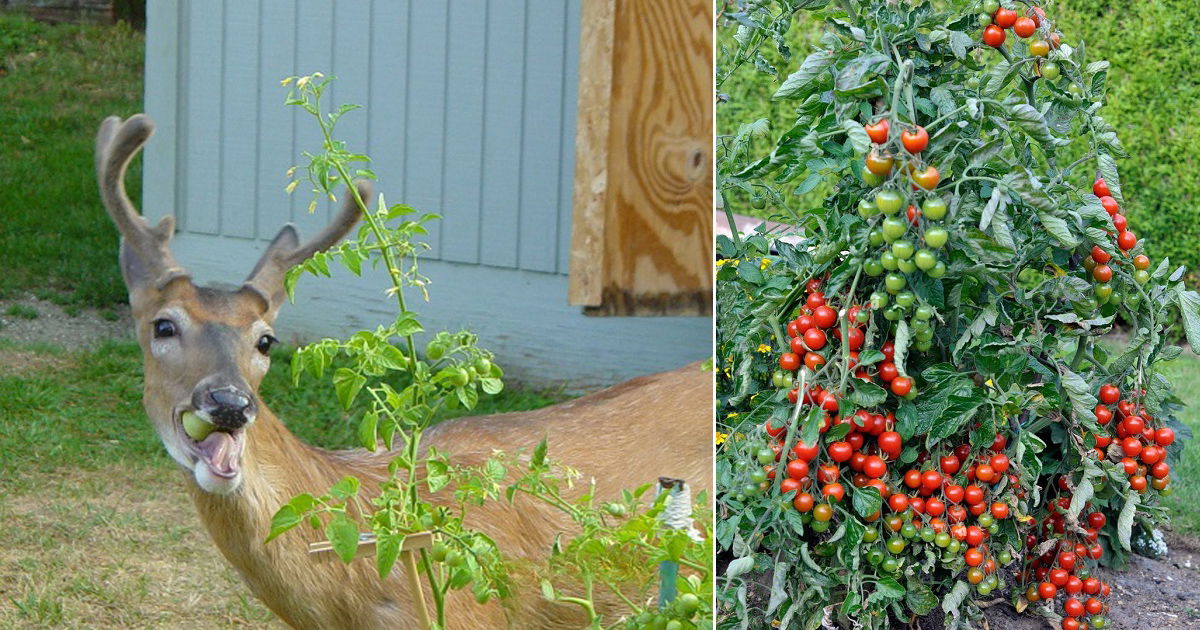Deer Eat Tomato Plants: Prevention and Mitigation Strategies. Deer are known to be fond of tomatoes, and they can cause significant damage to tomato plants if they are not kept away. There are a number of things that can be done to prevent deer from eating tomato plants, including using physical barriers, chemical deterrents, and companion planting.
Deer are attracted to tomato plants because they are a good source of food. Tomatoes are high in sugar and water, and they are a good source of vitamins and minerals. Deer also like the taste of tomatoes, and they will often eat them even if they are not hungry.
Deer’s Diet and Plant Preferences

Deer are primarily herbivores, consuming a wide range of plant materials to meet their nutritional needs. Their diet consists of various plant parts, including leaves, twigs, buds, fruits, and grasses. The specific plants that deer consume depend on several factors, such as availability, nutritional value, and taste.
Nutritional Requirements
Deer require a balanced diet to maintain optimal health and growth. Their nutritional needs include proteins, carbohydrates, fats, vitamins, and minerals. Proteins are essential for building and repairing tissues, while carbohydrates provide energy. Fats are necessary for energy storage and hormone production. Vitamins and minerals play crucial roles in various bodily functions.
Factors Influencing Food Choices
The availability of food sources is a significant factor influencing deer’s food choices. Deer tend to consume plants that are readily available in their habitat. Nutritional value is another critical factor. Deer prefer plants that provide a higher nutritional value, as they need to consume a substantial amount of food to meet their energy demands.
Commonly Consumed Plants
- Grasses: Deer commonly consume various grass species, such as fescue, brome, and bluegrass. Grasses provide essential nutrients, including carbohydrates and fiber.
- Forbs: Forbs are non-grassy herbaceous plants that are often preferred by deer. Common forbs consumed by deer include clover, alfalfa, and chicory.
- Browse: Browse refers to the leaves and twigs of woody plants. Deer consume a variety of browse species, including maple, oak, and aspen.
- Fruits: Deer are known to consume fruits when available. Common fruits consumed by deer include apples, pears, and berries.
Tomato Plant Characteristics and Deer Resistance

Tomato plants (Solanum lycopersicum) possess unique characteristics that influence their attractiveness or unattractiveness to deer. Understanding these traits can guide gardeners in selecting and cultivating tomato varieties less susceptible to deer damage.
Physical and Chemical Characteristics
- Hairy Stems and Leaves: Tomato plants exhibit dense trichomes (hairs) on their stems and leaves. These trichomes create a physical barrier, deterring deer from browsing due to the rough texture and potential irritation.
- Strong Odor: Tomato plants emit a distinct odor due to the presence of volatile compounds such as terpenes and alkaloids. These scents can be unpleasant to deer, making them less likely to approach or consume the plants.
- Low Nutritional Value: Compared to other plants, tomato plants have a relatively low nutritional value for deer. The high water content and low protein levels make them less desirable as a food source.
Deer-Resistant Tomato Varieties
Several tomato varieties have been developed specifically for their resistance to deer. These varieties typically possess enhanced physical and chemical defenses, including:
- Thick, Hairy Foliage: Varieties like ‘Celebrity’ and ‘Park’s Whopper’ have dense trichomes that create a formidable barrier against deer browsing.
- Strong Odor: Tomatoes with high levels of terpenes and alkaloids, such as ‘Mortgage Lifter’ and ‘Cherokee Purple,’ produce strong scents that deter deer.
- Low Palatability: Some varieties, like ‘Rutgers 250’ and ‘Sunrise,’ have a bitter taste or low nutritional content that makes them unappealing to deer.
Tips for Choosing and Planting Deer-Resistant Tomatoes
- Variety Selection: Choose tomato varieties known for their deer resistance, such as those mentioned above.
- Planting Location: Plant tomatoes in areas where deer activity is less frequent or in fenced-in gardens.
- Companion Planting: Plant deer-repellent companion plants, such as marigolds, lavender, or rosemary, around tomato plants to create a natural deterrent.
Prevention and Mitigation Strategies: Deer Eat Tomato Plants

To protect tomato plants from deer, a range of strategies can be employed. These include physical barriers, chemical deterrents, and innovative methods.
Physical Barriers
Physical barriers, such as fencing and netting, can be effective in deterring deer. Fencing should be at least 8 feet tall and buried 1 foot underground to prevent deer from jumping over or digging under it. Netting can be placed over tomato plants or around the entire garden.
Chemical Deterrents
Chemical deterrents, such as repellents and taste deterrents, can also be used to keep deer away from tomato plants. Repellents work by emitting a strong odor that deer find unpleasant, while taste deterrents make plants unpalatable to deer.
Caution: Chemical deterrents should be used with care, as they can be harmful to pets and wildlife.
Creative and Innovative Methods, Deer eat tomato plants
In addition to physical barriers and chemical deterrents, there are a number of creative and innovative methods that can be used to protect tomato plants from deer.
- Companion planting: Planting certain plants, such as marigolds, mint, or garlic, near tomato plants can help to deter deer.
- Using decoy plants: Planting a few tomato plants outside of the main garden can draw deer away from the plants you want to protect.